Find the value of i1/i2 in figure if (a) R = 0.1Ω, (b) R = 1 Ω (c) R = 10 Ω. Note from our answers that in order to get more current from a combination of two batteries they should be joined in parallel if the external resistance is small and in series if the external resistance is large as compared to the internal resistances.

a) 0.57, b)1, c)1.75
Formula used:
Kirchhoff’s loop rule state that the algebraic sum of all the voltages in a loop will be zero. Or,
![]()
Solution:
a)
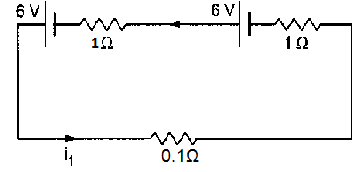
Given resistances are: 1 Ω,1 Ω,0.1Ω
Applying Loop rule, we can write,
![]()
Or,
![]()
And i1 will be,
![]()
In the next figure,
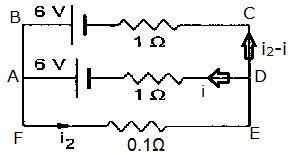
Let i be the current that passes through the middle branch and hence i2-i will pass through the upper branch, as shown in figure.
By applying loop rule in AFEDA, we can write as,
![]()
Or,
![]()
Similarly, applying the loop rule in ADCBA, we can write as,
![]()
Or,
![]()
Replacing ‘i’ in eqn.1 using eqn.2, we get,
![]()
Or,
![]()
Or,
![]()
Now i1/i2 is,
![]()
b)
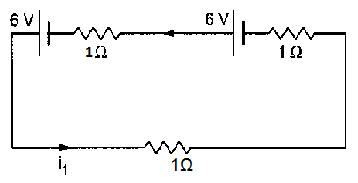
Given resistances are: 1 Ω,1 Ω,1Ω
Applying Loop rule, we can write,
![]()
Or,
![]()
And i1 will be,
![]()
In the next figure,
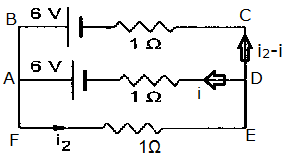
Let i be the current that passes through the middle branch and hence i2-i will pass through the upper branch, as shown in figure.
By applying loop rule in AFEDA, we can write as,
![]()
Or,
![]()
Similarly, applying the loop rule in ADCBA, we can write as,
![]()
Or,
![]()
Replacing ‘i’ in eqn.1 using eqn.2, we get,
![]()
Or,
![]()
Or,
![]()
Now i1/i2 is,
![]()
c)
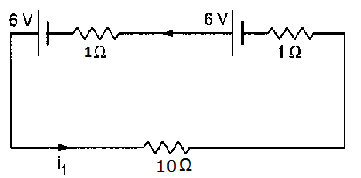
Given resistances are: 1 Ω,1 Ω,10Ω
Applying Loop rule, we can write,
![]()
Or,
![]()
And i1 will be,
![]()
In the next figure,
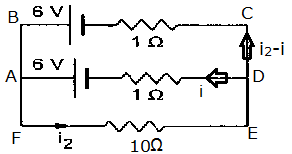
Let i be the current that passes through the middle branch and hence i2-i will pass through the upper branch, as shown in figure.
By applying loop rule in AFEDA, we can write as,
![]()
Or,
![]()
Similarly, applying the loop rule in ADCBA, we can write as,
![]()
Or,
![]()
Replacing ‘i’ in eqn.1 using eqn.2, we get,
![]()
Or,
![]()
Or,
![]()
Now i1/i2 is,
![]()